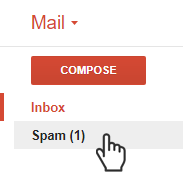Avoid Spam Filters with Better Email Notifications
A question we receive often from form owners is how to get email notifications through the recipient’s spam filters. While there are no tricks to always get through all filters, there are some tips on how to avoid most spam filters.
These tips include:
 Make sure it’s useful and relevant
Make sure it’s useful and relevant- Personalization for unique messages
- Use fewer links and typically-spammy content
- Do not use the same To and From address
- Use the right tool for the message
Avoid Spam Filters with Better Content
The best way to get the message to the intended recipient is to make the message expected and useful. For example, sending ‘thank you’ messages with no useful content can be avoided. Instead, use the Success Page to show a ‘thank you’ message.
Transactional emails are typically very highly relevant, such as receipts, password reset requests, etc. and frequently get clicked. Email clients (the programs used to read email) notice when the email messages are clicked and saved, which increases the likelihood that the messages are genuine.
Alternatively, email clients also notice when emails are deleted quickly or marked as spam. These messages tell the email client that emails coming from that sender with that content are likely to be spam. Therefore, the email client is more likely to mark similar messages as spam.
Better Content
 Personalization: Use pipe codes to personalize the email subject and messages. Not only is that a great reminder for the recipient that they requested the information, but it’s also a great way to vary the email content. The different content reduces the likelihood of matching with other messages, which is typical with spam messages.
Personalization: Use pipe codes to personalize the email subject and messages. Not only is that a great reminder for the recipient that they requested the information, but it’s also a great way to vary the email content. The different content reduces the likelihood of matching with other messages, which is typical with spam messages.
Fewer links & ‘spam’ content: Emails with a high link-to-text ratio are more likely to be spam, due to the emphasis on driving clicks rather than communicating. If the message doesn’t seem to provide much use, consider eliminating it completely.
Accountability: A typical spam message will use a From address that is not genuine, such as the same or similar to the To address. Be sure to either leave the From address blank or use the organization’s contact address for more legitimacy.
Avoid Spam Filters with Appropriate Tools
There are three basic tools available to companies looking to send emails, with distinct differences in the typical emails sent:
Personal email clients: These include private email addresses and the common email clients like Gmail, Yahoo, Outlook, etc. The messages typically sent from these addresses are highly specific to the recipients and are least likely to be spam.
Email marketing tools: Marketing systems like MailChimp or Constant Contact send bulk marketing emails and have systems in place to help senders reach their destinations. Their rules require high levels of accountability and ensure that all messages contain clear methods for recipients to remove their addresses from the lists.
Third-party senders: These systems let their customers send emails that encompass a wide range of topics, which makes evaluating for spam difficult. They can be transactional and personalized, or general and ‘spam-like’. Using a system like Formsite to send email notifications is an example of a third-party sender.